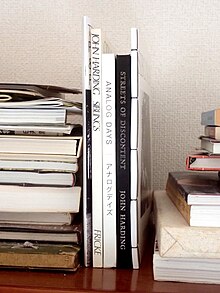American photographer
John Forrest Harding (born 1940) is a San Francisco–based photographer best known for the color street photography that he has pursued for four decades. Harding is the author of several photography books, and has taught courses on photography at City College of San Francisco and College of Marin.
Life and career
John Harding[n 1] was born on August 6, 1940[1] in Washington, D.C.[2]: 235 and grew up in Granite City, Illinois. He worked at Granite City Steel, studied at Southern Illinois University, took up photography after seeing the film Blow-up,[3] and studied at the San Francisco Art Institute[4] under Jack Fulton[n 2] and Henry Wessel, obtaining an MFA in 1976.[2]: 235
Harding has worked on commercial and editorial assignments (for Fortune and elsewhere[2]: 235 ), and has taught in the College of Marin[5] and the Photography Department of the City College of San Francisco.[4][5][6]
Separately from the work he was assigned to do,[3] Harding long photographed for his own interest. From 1975 to 1976, he made black and white portraits of adult brothers and sisters in the US.[2]: 235 Thanks in part to an NEA grant,[7] the series was published in 1982 in the photobooks Geschwister and Siblings; in 2016, he published a supplement, also titled Siblings.
Harding started to work in color in 1977.[2]: 235 Writing in 2011, Stacen Berg described him as having photographed on the street "[n]early every day for over 30 years" (and still using color 35 mm film in a Leica camera).[8]
In 1989, Susan Kismaric could write that street photography, "so prominent in the history of [photography], is practically nonexistent in California": as its exponents there, she could only name Harding, Wessel and Bill Dane in San Francisco, and Anthony Hernandez on Rodeo Drive.[9]
Harding's street photography of the 1980s was sampled in the 1987 book American Independents. Its editor, Sally Eauclaire, wrote that Harding's photographs had the objective of "[deriving] poetic fancy from prosaic fact", that "Their kaleidoscopically shifting shapes and colors reveal much about the jostle of humanity as well as trends in fashion and social and sexual mores." Eauclaire praised Harding's achievement of "[pushing] realism into the realm of surrealism", attained via devices of isolation within crowds, of reflections, "helterskelter highlighting, and hedonistic jostlings of color". Yet Harding managed to declare "solidity, permanence, and the possibility of definition".[2]: 79–80
A larger collection did not appear in print until the 2011 publication (in Japan) of Harding's photobook Analog Days, which had photographs taken from 1979 to 2009, and about which Stan Banos writes:
One sees much street photography that relies on a single formula, Harding's work mixes it up, with content, composition and yes, color, all vying and battling it out for domination, or the creation of some tenuous, dynamic coexistence. It draws you in, excites you and keeps you interested.[10]
In a foreword to Analog Days, Sandra S. Phillips writes that its photographs "are so direct, and so marvelously natural, that for a moment we forget that they were framed and 'taken' by someone." She concludes that "Street photography has the potential to reveal our social selves to us, and as Harding's viewfinder shows, it can also provide a particular gracefulness and wonder."
Harding's next full-scale book was Streets of Discontent, published in a small edition in 2018. Again collecting color views of the streets of San Francisco, but this time consisting of very recent work, its subtlety is praised by Corey Keller, who also points out that:
[This work] coincides with a moment in which [San Francisco] seems to teeter on the brink as the gap between the haves and the have-nots widens daily into a chasm. The splendor of the city's soaring new buildings is matched only by the wretchedness of those who live on its streets. Harding's pictures neither elevate nor condemn. They just ask us to notice.[11]
